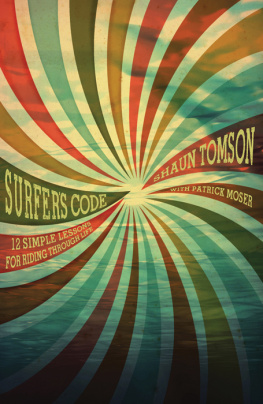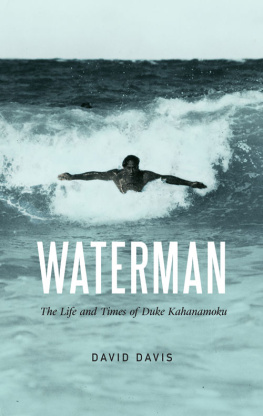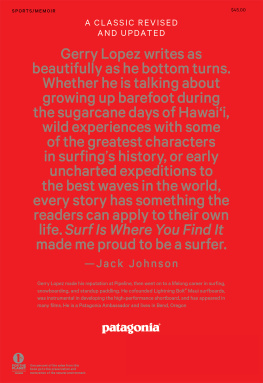
The Greatest Surfriders from Duke Kahanamoku to Kelly Slater
LEGENDS OF SURFING
DUKE BOYD
Photography by Jeff Divine
Foreword by Steve Pezman


First published in 2009 by MVP Books, an imprint of MBI Publishing Company and the Quayside Publishing Group, 400 First Avenue N, Suite 300, Minneapolis, MN 55401 USA
Copyright 2009 by Duke Boyd
All rights reserved. With the exception of quoting brief passages for the purposes of review, no part of this publication may be reproduced without prior written permission from the Publisher.
The information in this book is true and complete to the best of our knowledge. All recommendations are made without any guarantee on the part of the author or Publisher, who also disclaim any liability incurred in connection with the use of this data or specific details.
This publication has been prepared solely by MBI Publishing Company and is not approved or licensed by any other entity. We recognize that some words, model names, and designations mentioned herein are the property of the trademark holder. We use them for identification purposes only. This is not an official publication.
MVP Books are also available at discounts in bulk quantity for industrial or sales-promotional use. For details write to Special Sales Manager at MBI Publishing Company, 400 First Avenue N, Suite 300, Minneapolis, MN 55401 USA.
To find out more, visit us online at www.MVPBooks.com.
Digital edition: 978-1-616-73108-3
Hardcover edition: 978-0-760-33599-4
Library of Congress Cataloging-in-Publication Data
Boyd, Duke.
Legends of surfing : the greatest surfriders from Duke Kahanamoku to Kelly Slater /
Duke Boyd ; photography by Jeff Divine ; foreword by Steve Pezman.
p. cm.
ISBN 978-0-7603-3599-4 (hb w/ jkt)
1. SurfersBiography. 2. Women surfersBiography. 3. SurfersInterviews.
4. Women surfersInterviews. I. Divine, Jeff. II. Pezman, Steve. III. Title.
GV837.9.B69 2009
797.320922dc22
[B] 2009016016
Editor: Michael Dregni
Design Manager: LeAnn Kuhlmann
Design by: Sarah Bennett
On the frontispiece: Walter Hoffman. Walter Hoffman collection
Opposite the title page: Kelly Slater.
Printed in China

Contents

FOREWORD
by Steve Pezman
INTRODUCTION
Legendary Surfriders of the Twentieth Century
PART 1
Pioneer Surfriders
PART 2
The Golden Age
PART 3
The Progressive Surfriders
PART 4
Legendary Women Surfriders
PART 5
Board Builders
PART 6
Legendary Big Wave Surfriders
PART 7
The Surfing Media
PART 8
Surfing Filmmakers
PART 9
Banzai Pipeline Masters
PART 10
The Surf Culture
PART 11
Surf Photographers
PART 12
Tow-In Surfriders


Foreword
In the SPRING of 1963, this guy walked into OLE SURFBOARDS on Bay Boulevard in Seal Beach, California, where I worked as manager Mickey Muozs left-hand man. This was in a time when surf shops sold surfboards, period! The use of neoprene wetsuits hadnt yet arrived, and the only other auxiliary income such a retail operation might allow itself to derive came from patching dinged boards. Selling other stuff was considered sissy, nonpurist.
The guy was wearing a madras shirt, black pants, and brown leather shoes with white socks. He turned out to be a salesman, and he wanted us to carry his new brand of surf trunks called Hang Ten. We flat out refused to even consider selling surf trunks to our customers, and he eventually went down the highway a few miles to Huntington Beach and successfully talked Jack Hokanson into carrying his trunks. The parable to this story is, Ole Surfboards ceased operations some years later while Jacks Surf Shop grew into a multimillion dollar business that sold everything under the sun related to surf and beach. The guy who tried to convince us of what was around the corner was named Duke Boyd. Muoz and I became lifelong friends with him, but we never bought his trunks. He gave them to us.
Hang Ten was the first commercially produced authentic surf trunk, and the company eventually topped a hundred million dollars a year in sales. Hang Ten also owned the ad space on the back cover of Surfer magazine where Duke articulated Hang Tens relationship with the sport of surfing in ways that other companys couldnt fathom. One of Dukes secrets to success with Hang Ten was that he picked a very graphic logo symbol that represented a high level of skill (and corn) to surfing acolytes. Then he moved the logo from being hidden inside the collar and placed it boldly on the chest; he infused that logo with so much promotion and romance that the name quickly lost its corn factor and became a household word for surf trunks and raglan-sleeve woven shirts in every color of the rainbow. That was another of Dukes secrets. If you wanted to do volume, you created a branded basic that everyone needed and bought, then got them to buy into your brands cool factor rather than some meaningless mark.
Early in his Hang Ten years, just as Wide World of Sports was first flourishing, Duke saw surfing as a potential TV sports subject that was being ignored because it was misunderstood. While managing an apartment in Long Beach to get free rent, he invited all the sports heroesPhil Edwards, Dewey Weber, Corky Carroll, Donald Takyama... maybe twenty-five to thirty of themto his apartment to talk them into forming a professional surfers union and present the concept of covering a worldwide series of competitions to network television. As a group, they found the idea interesting, but no one pursued it.
While Duke was building Hang Ten, his friend Dick Graham was serving as publisher of Petersons International Surfing magazine, which was floundering in second place behind the seminal Surfer magazine. Graham hired Duke as managing editor to help create authentic content and to merchandise that title like he did his clothing brand. Graham was a jock and body surfer, and Duke was hooked into the surf scene, so Duke started going to his beach buddies at Huntington Pier near where he lived, recruited them as test riders for his surf trunks, well before anyone had team riders, and started Graham running articles on and by those underground heroes. That strategy worked in both cases.
















